Table of Contents
Seating Arrangement questions are an integral part of the Logical Reasoning section in various competitive exams like SSC, Railways, Banking, and Defence. These questions are designed to assess a candidate’s logical reasoning and problem-solving abilities. Typically, seating arrangement questions account for a weightage of around 4-6 marks or 2-4 questions in these exams. Given the significance of this topic, it is crucial for students to prepare and practice seating arrangement questions thoroughly.
Mastering the skills required to solve seating arrangement problems can significantly contribute to a candidate’s overall performance in the competitive exam. Therefore, students should allocate sufficient time and effort to understand the concepts and strategies involved in solving such questions effectively.
Seating Arrangement Reasoning Questions
In reasoning, when some details and hints are given based on the seating of the people and their arrangement are made as per the hints and instructions called seating arrangement questions. Seating arrangement reasoning questions contain the seating in a straight line, circular, rectangular, or any other way. The students need to make a seating arrangement as per the given condition and then find the required solution to the question. It firms a puzzle and the answer can be found logically. Some important seating arrangement reasoning questions are given here for practice which will boost your upcoming exam preparation.
Seating Arrangement Tricks
The students need to follow effective seating arrangement tricks and tips to solve the seating arrangement questions easily and quickly to crack the exam. Seating arrangement questions requires a good understanding of directions and puzzle-solving skills. Seating arrangement tricks help you to emphasize your preparation level and to increase your score also. The candidates need to follow these tricks to solve the seating arrangement questions quickly and with accuracy. Some seating arrangement tricks are discussed here.
- Read the Question Carefully
- Understand all the given conditions and instructions well
- Draw a general diagram according to the given condition
- Identify the direction of a particular person or object which is asked in the question.
Seating Arrangement Formula
Seating arrangement questions are formed on various types of sitting including straight line, circular, square, rectangular or any other manner. The seating arrangement formula will help to solve all types of seating arrangement questions quickly. The students can refer to the below picture for understanding the types of seating arrangements. The seating arrangement formula consists of a smart way to solve the questions in exams.
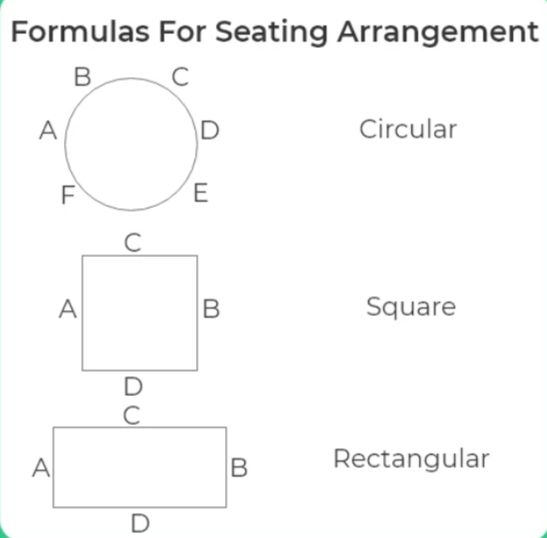
Seating Arrangements Questions with Answers
The important seating arrangement questions are discussed below for all the upcoming exam preparation. The candidates must practice these questions well to crack the exams with a good score.
Directions (Que.1-5): Read the given information carefully and answer the problems given below:
Eight persons A, B, C, D, E, F, G, and H are sitting around a circular table but do not needs to be sitting in the same arrangement. Five of them are facing inner while others are facing outward.
E is third to the right of C. F sits third to the left of E. Three persons sit between F and B. G sits third to the right of F who is not facing the center. D sits third to the right of A, who is not facing the center.
Que.1 Who sits just between F and A?
(a) B
(b) C
(c) E
(d) D
(e) None of these
Ans – (e) None of these
Que.2 Who among the following is second to the right of B?
(a) D
(b) C
(c) E
(d) H
(e) None of these
Ans – (b) C sits second to the right of B.
Que.3 Which of the following statements is/are true concerning P?
(a) H is the opposite of G
(b) H is fourth to the right of G.
(c) H is fourth to the left of G
(d) All are true
(e) None of these
Ans – (d) All the given statements are true
Que.4 Who among the following is second to the right of the one who is suddenly left of H?
(a) D
(b) C
(c) E
(d) F
(e) None of these
Ans – (b) C is sudden left of H
Que.5 Who among the following sits opposite A?
(a) B
(b) C
(c) E
(d) G
(e) None of these
Ans – (b) C sits opposite to A
Solution: Based on the given condition, a general diagram can be made as shown here to get answers by referring to this figure.
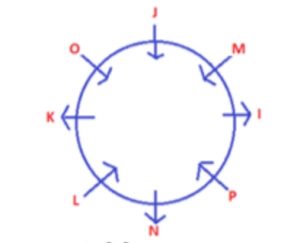
Directions (Que.6-10): Read the following given information carefully and answer the given questions:
A group of eight friends – P, Q, R, S, T, U, V, and W are sitting in a straight line with north facing. P sits third to the right of U. Neither P nor U sits at the extreme edges of the line. T is not an immediate neighbor of either P or U. One person is sitting between W and R. Q sits at an end of the line. q sits on the immediate right of P. T doesn’t sit to the left of S.
R sits at the 4th position from either end of the row.
Que.6 How many persons sit between W and P?
(a) One
(b) Three
(c) Two
(d) Five
(e) None of these
Ans – (c) Three persons are sitting between W and P.
Que.7 Who sits just between S and V?
(a) W
(b) P
(c) T
(d) U
(e) None of these
Ans – (d) U, sits just between S and V
Que.8 How many persons sit between U and Q?
(a) One
(b) Three
(c) Two
(d) Five
(e) None of these
Ans – (b) Three persons sit between U and Q
Que.9 What is the position of S concerning U?
(a) Second to the left
(b) Third to the left
(c) Third to the right
(d) Second to the right
(e) None of these
Ans – (d) S is second to the right of U
Que.10 If V is related to T and U is related to P, then similarly, S is related to?
(a) W
(b) T
(c) R
(d) U
(e) None of these
Ans – (c) S is related to R
Que.11 Six persons A, B, C, D, E & F are sitting around the circle as B is between D & C, A is between E & C, and F is at the right of D. Find who sits between A and F.
(a) E
(b) C
(c) D
(d) F
(e) None of these.
Ans (A)
Solution:
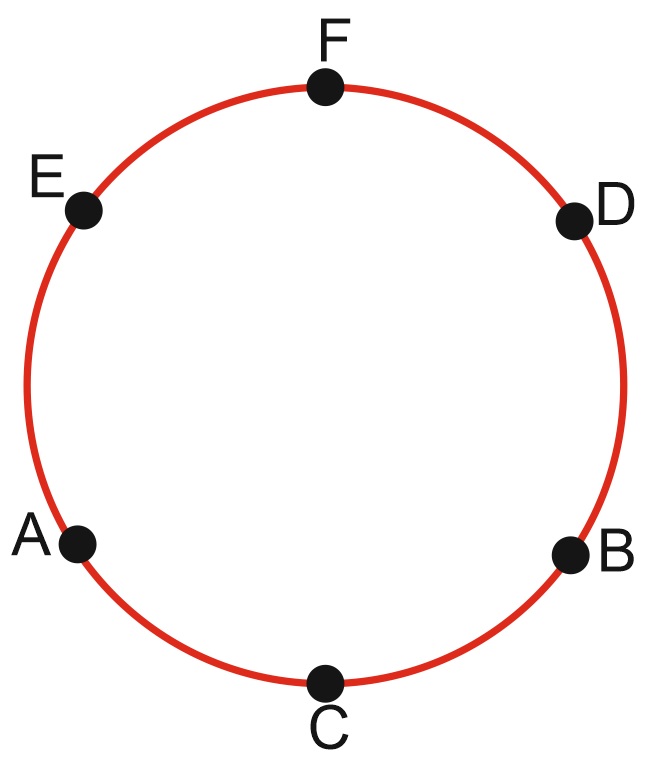
Directions: (Que.12-16) Read the given statements carefully and answer the following questions.
(A) P, Q, R, S, T, U, and V are sitting around a circle facing towards the center.
(B) P sits between V and S.
(C) R, who is second to the right of S, is sitting between Q and U.
(D) Q is not the neighbor of T.
Que.12 Which of the following statement is true?
(a) V is between P and S.
(b) S is second to the left of V
(c) R is third to the left of P
(d) P is at the immediate left of S
(e) None of these
Ans – (d) P is at the immediate left of S
Que.13 What is the position of T?
(a) between R and V
(b) just left of V
(c) second to the left of R.
(d)second to the right of P
(e) None of these
Ans – (b) just left of V
Que.14 Who is sitting between R and U?
(a) T
(b) S
(c) V
(d) Q
(e) None
Ans – (a) T
Que.15 Which of the following statement is wrong for the given condition?
(a) R is at the immediate right of U
(b) Q is at the immediate left of R
(c) T is third to the right of Q
(d) U is third to the right of T
Ans – (a) R is at the immediate right of U
Que.16 In which of the following pairs, the second member is just the right of the first member?
(a) QS
(b) PV
(c) RU
(d) VT
Ans – (c) RU
Solution:
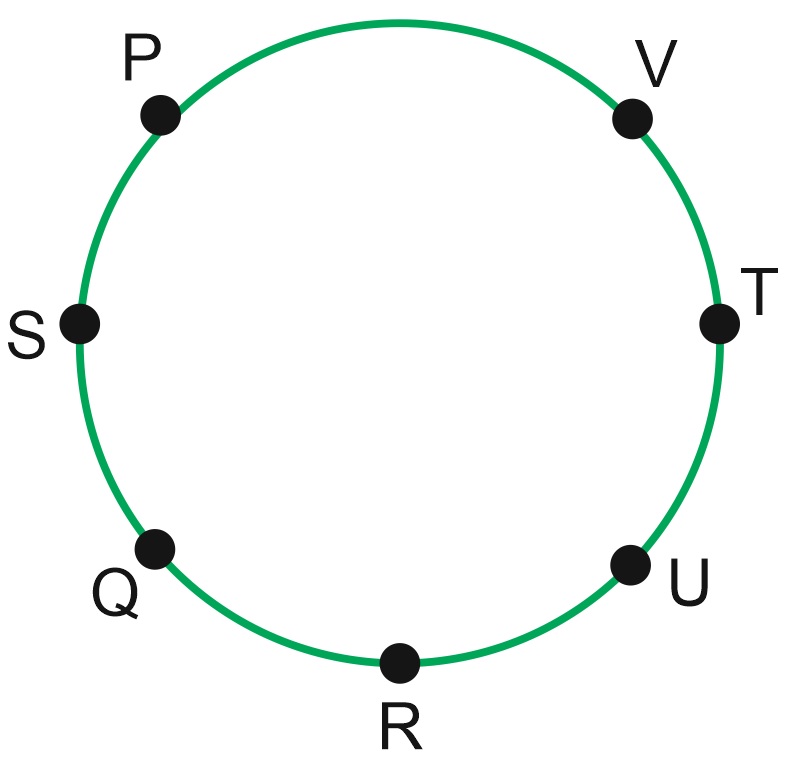
| Check Related posts: | |
| Syllogism, | Venn Diagrams |
| Profit and Loss | Time & Work |




 SSC Calendar 2025 Under Review, Revised ...
SSC Calendar 2025 Under Review, Revised ...
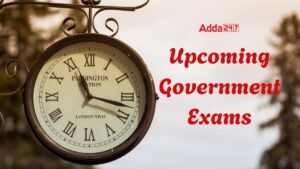 Upcoming Government Exams, Complete Govt...
Upcoming Government Exams, Complete Govt...
 Govt Jobs 2025, Latest Upcoming Governme...
Govt Jobs 2025, Latest Upcoming Governme...


